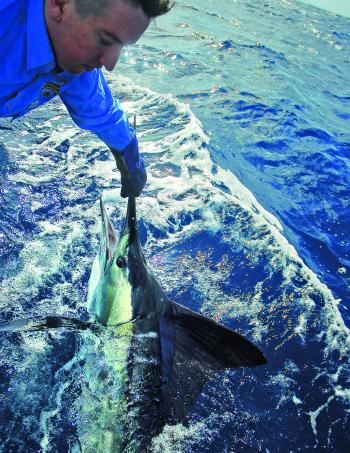Offshore this month sees water temperatures drop and the winds will mostly blow from the west. Despite this, I think there will still be some good marlin action on the wider grounds.
Early winter has seen the best run of striped marlin in years. From the 80m line out to well wide of the continental shelf, there have been quite a few striped and blue marlin caught and plenty of bait. It pays to downsize your usual blue marlin lures to something a bit smaller, and run your strike drags a bit lighter.
Striped marlin are harder to hook than blues, and tend to repeatedly bill the lure without properly eating it. If you have a live bait or well rigged pitch bait, it’s usually effective to ‘switch’ a fish once it has been teased up on a lure. There is also a good chance of hooking big yellowfin tuna this month, particularly out wide of the thousand fathom line.
There has been a lot of interest in chasing broadbill swordfish over the past few months and as the current drops the fishing may improve. Well-known local skipper Craig Denham has already caught two swordfish off the Gold Coast this year and hopefully there will be more caught this month. These fish have been on the 600m line and have been caught in daylight hours using squid fished around 500m down on breakaway weights.
In closer to shore the snapper should improve this month as the schools of spawning fish move into the 36 and 24 fathom reefs. Float lining, soft plastics and octa jigs all work well. A few fish over 8kg should turn up this month. Pearl perch should become more abundant on the 50 fathom line as well as amberjacks, pigfish and kingfish. It pays to watch out for any forecast of winds over 15 knots from the northwest this month – the wider grounds can become extremely rough when the wind picks up and it can be a wet, cold and very slow trip home.
The close reefs should see good catches of cobia and mulloway this month. Cobia start to migrate north at this time of year and tend to move along the 18 and 20 fathom line. These fish will hold in any area that has a lot of bait. They also love to feed around isolated wrecks.
To catch cobia the best method is to anchor and berley using large chunks of fish. These fish have massive mouths and will eat a wide variety of baits. They are also partial to large soft plastics such as 7” Gulp Jerk shads. My favourite baits for cobia are live tailor, large slimy mackerel, pike and bonito. I fish one bait mid-water and another about 2m up off the bottom. They also respond well to floating pilchards and love plenty of berley.
Mulloway should be in good numbers this month. The artificial reef northeast of the Seaway in 23m of water has been producing a lot of fish around a metre long on a pretty consistent basis. Live baits fished close to the structure on dusk through to dark seem to be a very reliable method. They also seem to be more active on tide changes.
As the westerlies start to blow a lot of fish begin their spawning run. Large schools of sea mullet, bream and luderick congregate in the Seaway, Jumpinpin Bar and around the river entrances in preparation for moving out along the beaches to spawn. These attract quite a few bigger predators such as mulloway and sharks. Good targets in the estuaries this month are flathead, bream, mulloway and luderick. Most of my biggest estuary mulloway have been caught in July.
In general July is a dry month. For this reason the water should be pretty clean. Flathead fishing can be excellent with good numbers of fish from 40-70cm turning up in the central Broadwater from around Crab Island through to Tipplers Passage and also up Whalleys Gutter. There have been a lot of smaller fish early this season and they have been biting well.
With flathead fillets going for over $40/kg, it’s good to catch a feed of prime fish. Fried in Panco crumbs they are hard to beat. I like to mix up my methods over a day and troll and cast depending on the tide and the spot. In July we tend to troll on the high tide and cast when the water drops off the flats.
Mulloway fishing in the Seaway and Jumpinpin entrances should be good this month. Most of the bigger fish are caught at night on live mullet fished in the eddies around the Seaway on the change of a high tide. I use 10kg mono, no weight and a leader of around 30lb. These fish tend to be quite shy and I have found that they often drop the bait when fished on braid.
Mullet can usually be caught with a cast net along the rock walls of the south wall of the Seaway. In daylight hours soft plastics and live baits fished in the Jumpinpin Bar and in the hole at the end of the north wall of the Seaway are usually effective. Tide changes and the run in tide fish best. Work the back eddies when the current flows hard and the deeper holes on the slack period of the tide.
Overall, July is a good month to fish the Gold Coast and there are a lot of options. The estuaries seem to come alive in the middle of winter and it is a great month to chase quality table fish.
Reads: 3093
Michael Green pulling up a striped marlin.

The author with a cracker 110cm mulloway.

Mark Frendin with a big Jumpinpin flathead.




